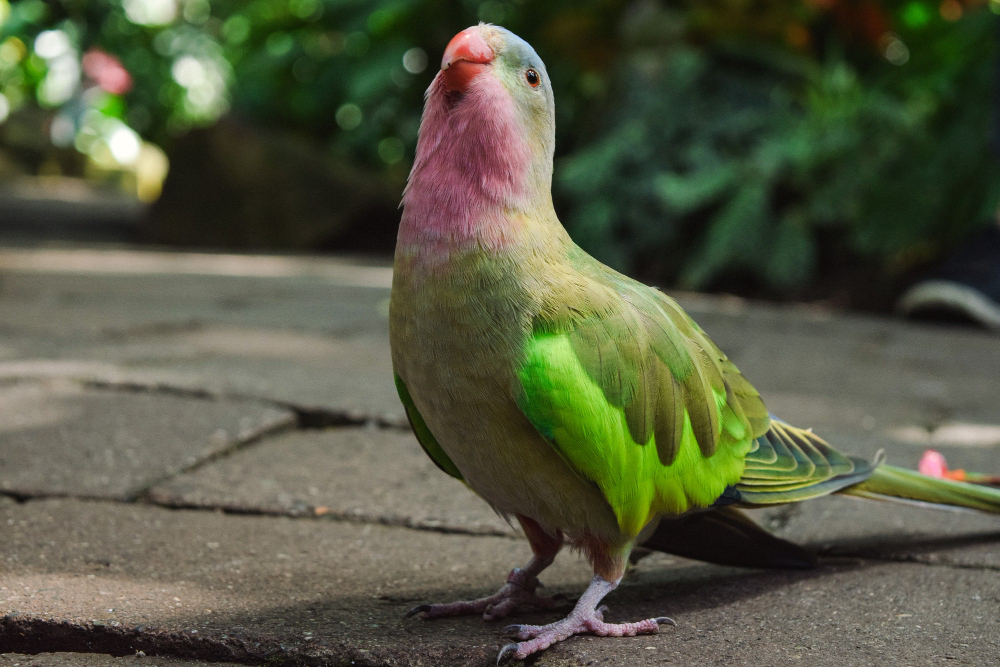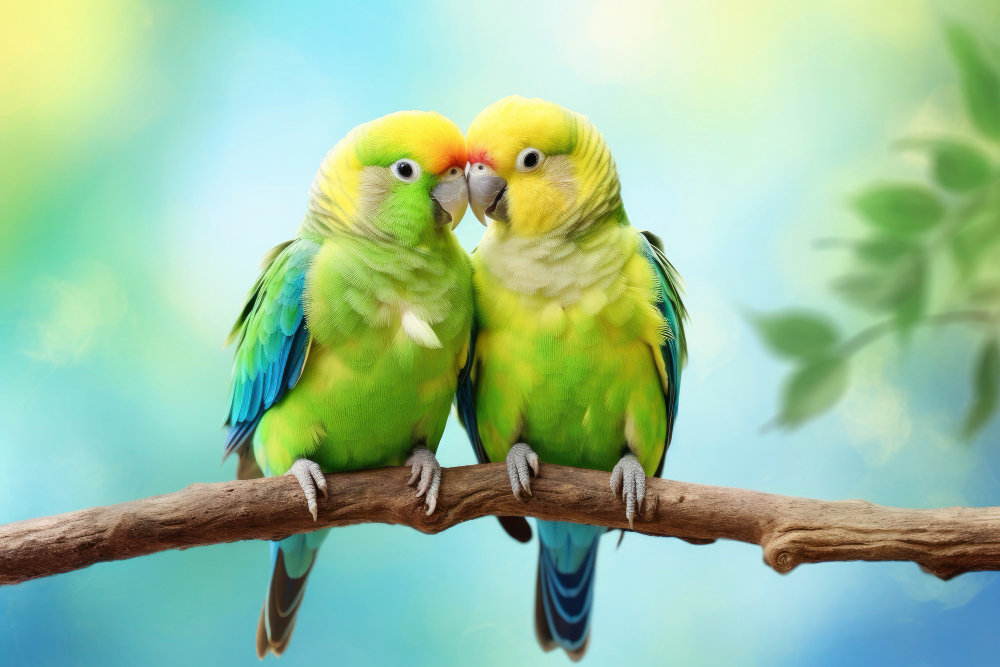The Lovebird may be small in size, but it carries a personality as bright as its colourful feathers. Belonging to the parrot family, these charming little birds are best known for their playful energy and affectionate nature. True to their name, Lovebirds often form deep, lifelong bonds both with their mates and with the humans who care for them. Watching a pair of Lovebirds preen each other or snuggle closely on a perch is one of the sweetest sights in the bird world, a living symbol of loyalty and companionship.
But their appeal doesn’t stop with affection. Lovebirds are brimming with character and curiosity, always eager to climb, chew, explore, and play. Despite their small size, they have a big presence in the home, filling it with chirps, chatter, and bursts of activity. Their vibrant plumage and engaging personalities have made them one of the most beloved pet parrots worldwid perfect for bird lovers who want a companion that is both lively and deeply connected.
Appearance of the Lovebird
| Feature | Description |
| Size | Small parrot, 5–7 inches tall, weighing 40–60 grams |
| Coat/Feathers | Bright plumage; common colours include green, peach-faced, yellow, and blue |
| Face | Strong, hooked beak with expressive eyes |
| Tail | Short and rounded |
| Overall Look | Compact, colourful, and lively |
A Glimpse Into Their History
Lovebirds are native to Africa and Madagascar, where they live in flocks and are known for their strong pair bonds. The name “Lovebird” comes from their tendency to sit closely with their mate, grooming and showing affection. There are nine recognised species, with the Peach-Faced, Fischer’s, and Masked Lovebirds being the most common in captivity.
Types of Lovebirds
| Type | Distinct Features |
| Peach-Faced | Green body, peach or pink face, most common type in captivity. |
| Fischer’s | Vibrant green body, orange face, blue tail feathers. |
| Masked | Yellow chest, dark brown “mask” face, green body. |
| Black-Cheeked | Similar to Fischer’s but with black cheeks and smaller size. |
| Nyasa (Liliane’s) | Green plumage, reddish forehead, native to Southeast Africa. |
| Madagascar | Smallest species; plain green with less vibrant markings. |
Personality and Behaviour
Lovebirds are intelligent, curious, and affectionate parrots.
- Bonding: They form strong attachments with mates and caretakers.
- Playful: Enjoy toys, climbing, and exploring.
- Social: Thrive on interaction and can become lonely if neglected.
- Energetic: Love flying and need space to stretch their wings.
- Vocal: While not as loud as larger parrots, they can be chirpy and chatty.
Food and Diet Needs
A balanced diet keeps lovebirds healthy and active:
- Seeds and pellets as a base diet.
- Fresh fruits and vegetables (apples, carrots, spinach, broccoli, berries).
- Protein treats like boiled eggs or legumes occasionally.
- Fresh water daily in a clean dish.
- Avoid toxic foods such as avocado, chocolate, caffeine, and alcohol.
Grooming and Maintenance
Caring for a lovebird requires consistent attention:
- Cage: Spacious cage with horizontal bars for climbing.
- Toys: Chewable toys, swings, and perches for stimulation.
- Bathing: Provide shallow water dishes or mist sprays for feather care.
- Nail trimming: Needed if nails grow too long.
- Beak care: Chew toys help keep the beak naturally filed.
Exercise and Activity
Lovebirds are highly active parrots and need daily exercise:
- Free-flight time outside the cage in a safe environment.
- Interactive playtime with toys or human interaction.
- Climbing and chewing activities to keep their minds engaged.

Common Illnesses and Health Concerns
Lovebirds are generally healthy but can be prone to:
- Psittacine Beak and Feather Disease (PBFD) – affects feathers and beak.
- Respiratory infections – often caused by drafts or poor hygiene.
- Nutritional deficiencies – from seed-only diets.
- Parrot fever (Psittacosis) – rare but possible.
Regular vet check-ups and a balanced diet prevent most health problems.
Training and Socialisation
Lovebirds are intelligent and can be trained with patience:
- Step-up command – basic handling training.
- Hand-taming – builds trust and bond.
- Trick training – some can learn simple tricks like turning around.
- Socialisation – regular interaction prevents aggression or biting.
Fun and Exciting Facts About Lovebirds
Here are some fascinating things that make Lovebirds truly special:
- Lovebirds got their name because they form lifelong monogamous bonds.
- They are one of the smallest parrot species, yet full of big personality.
- Lovebirds can recognise their owners and often show affection by preening them.
- Unlike some parrots, they don’t talk much, but their chirps and chatter are unique.
- Wild lovebirds can live in large flocks of 100+ birds.
- Some lovebirds have been known to mimic household sounds like doorbells or phones.
Should You Get a Lovebird?
If you want a small, colourful, and affectionate parrot, the lovebird is a wonderful choice. They do require daily interaction, a stimulating environment, and proper care. In return, they’ll provide endless companionship and playful affection.
Frequently Asked Questions About Lovebirds
Q1: Do lovebirds need to be kept in pairs?
Not always. While they bond strongly with other lovebirds, single lovebirds can thrive with enough human interaction.
Q2: How long do lovebirds live?
With proper care, lovebirds live 10–15 years in captivity.
Q3: Can lovebirds talk?
Lovebirds aren’t known for talking like larger parrots, but they can mimic sounds and develop a chirpy vocabulary.
Q4: How big should a lovebird’s cage be?
At least 24 x 18 x 24 inches, with room for toys and perches.
Q5: Are lovebirds noisy?
They are moderately vocal — more chirpy than loud, making them manageable in apartments.







